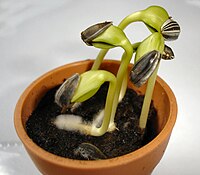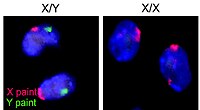
Pollen limitation and autonomous selfing ability interact to shape variation in outcrossing rate across a species range.
Sign Up to like & getrecommendations! Published in 2019 at "American journal of botany"
DOI: 10.1002/ajb2.1342
Abstract: PREMISE Hermaphroditic plants commonly reproduce through a mixture of selfing and outcrossing. The degree to which outcrossing rates reflect the availability of outcross pollen, genetic differentiation in the ability to autonomously self-fertilize, or both is… read more here.
Keywords: variation; limitation; autonomous selfing; outcrossing rates ... See more keywords

Changes in female function and autonomous selfing across floral lifespan interact to drive variation in the cost of selfing
Sign Up to like & getrecommendations! Published in 2022 at "American Journal of Botany"
DOI: 10.1002/ajb2.1816
Abstract: Abstract Premise Morphological and developmental changes as flowers age can impact patterns of mating. At the same time, direct or indirect costs of floral longevity can alter their fitness outcomes. This influence has been less… read more here.
Keywords: floral lifespan; across floral; selfing across; seed ... See more keywords

Do floral traits and the selfing capacity of Mimulus guttatus plastically respond to experimental temperature changes?
Sign Up to like & getrecommendations! Published in 2019 at "Oecologia"
DOI: 10.1007/s00442-019-04558-y
Abstract: Climate change can negatively impact plant–pollinator interactions, and reduce outcross pollination. For reproductive assurance, an increased capacity for autonomous selfing should benefit the persistence of plants under new temperature conditions. Plastic responses of the autonomous… read more here.
Keywords: guttatus; seed; temperature; capacity ... See more keywords

Geographic variation in floral traits and the capacity of autonomous selfing across allopatric and sympatric populations of two closely related Centaurium species
Sign Up to like & getrecommendations! Published in 2017 at "Scientific Reports"
DOI: 10.1038/srep46410
Abstract: Floral traits and the relative contribution of autonomous selfing to total seed set varies geographically and is often driven by the availability and abundance of suitable pollinators and/or the presence of co-flowering relatives. In the… read more here.
Keywords: capacity; allopatric sympatric; floral traits; autonomous selfing ... See more keywords

Prior selfing can mitigate the negative effects of mutual reproductive interference between coexisting congeners
Sign Up to like & getrecommendations! Published in 2019 at "Functional Ecology"
DOI: 10.1111/1365-2435.13344
Abstract: When more than one closely related plant species share the same pollination niche, reproductive interference via interspecific pollen transfer should limit their coexistence. However, some studies have reported the sympatric coexistence of two native close… read more here.
Keywords: seed; interference; autonomous selfing; pollination ... See more keywords

Occurrence and Prevention of Delayed Autonomous Selfing in Salvia umbratica (Lamiaceae)
Sign Up to like & getrecommendations! Published in 2021 at "Frontiers in Plant Science"
DOI: 10.3389/fpls.2021.635310
Abstract: Delayed autonomous selfing (DAS) provides reproductive assurance under conditions of pollinator and/or pollen-limitation. Few plant species have been investigated to determine if DAS is terminated when a flower is sufficiently pollinated by a pollen vector,… read more here.
Keywords: delayed autonomous; seed; autonomous selfing; seed set ... See more keywords

Evolution of Autonomous Selfing in Marginal Habitats: Spatiotemporal Variation in the Floral Traits of the Distylous Primula wannanensis
Sign Up to like & getrecommendations! Published in 2021 at "Frontiers in Plant Science"
DOI: 10.3389/fpls.2021.781281
Abstract: Outcrossing plant species are more likely to exhibit autonomous selfing in marginal habitats to ensure reproduction under conditions of limited pollinator and/or mate availability. Distyly is a classical paradigm that promotes outcrossing; however, little is… read more here.
Keywords: floral traits; variation floral; autonomous selfing; seed ... See more keywords